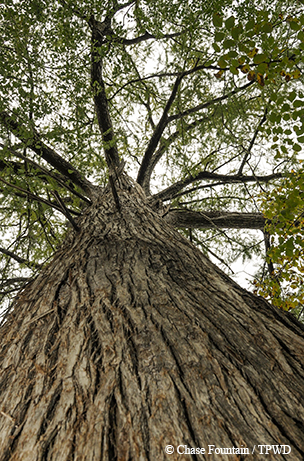
Silent Sentinels
The legendary trees of our state parks tell the story of Texas.
By Russell Roe
Former Gov. James Stephen Hogg's dying wish was about trees. Before he passed away in 1906, he told his loved ones that he wanted a pecan tree to be planted at the head of his grave instead of a stone or marble monument. He wanted the nuts to be given to the people of Texas with the dream of making the state "a land of trees."
The State Horticultural Society, in accordance with Hogg’s request, planted two pecan trees at the head of his grave in Austin and a black walnut tree at his feet, and their nuts were in fact distributed across the state. In 1919, with the popularity of the native tree growing, thanks in part to Hogg, the pecan was named the state tree of Texas.
Trees connect us in many ways. Hogg knew that. We gather under them, seeking their shade on a hot day. We admire them for their beauty. We see them as a link to the past and a bridge to the future. Trees have the remarkable ability to combine natural and cultural history in ways that few other objects can. Every tree tells a story, and some of them have great stories to tell.
Our Texas state parks contain many remarkable trees. Four of them have risen to such a level of historical importance that they have been included on the Texas A&M Forest Service’s Famous Trees of Texas Registry.

La Bahía Pecan
When delegates gathered in the town of Washington in March 1836 to declare independence from Mexico, a young pecan tree stood near the ferry crossing on the Brazos River. These were tumultuous times — the Alamo was under siege, and the delegates were torn between going to the aid of the soldiers and staying to work on a new government. They hunkered down, declared independence and established the Republic of Texas.
After the Alamo fell, settlers started streaming through Washington in a desperate attempt to stay ahead of Mexican Gen. Santa Anna and his advancing army. The fleeing settlers camped out along the river, likely next to the tree, waiting for their turn to load their wagons and families on the ferry in the retreat known as the Runaway Scrape.
The La Bahía Pecan, at what is now Washington-on-the-Brazos State Historic Site, bore witness to these events — some of the most important in Texas history.
“This is considered to be what’s called a ‘witness tree’ because of its age and the dramatic events that it has been through here,” says Catherine Nolte, park superintendent.
Travelers had been this way before. The historic La Bahía Road, running through the park, started as a Native American trail across Texas and later served as a route for Spanish explorers. DNA testing shows that the La Bahía Pecan is related to trees in Tamaulipas, Mexico.
“Since the tree is in proximity to La Bahía Road, it lends credence to the idea that people were traveling and there was dispersal of plants and other things, just like we have today,” Nolte says. “We don’t know for sure how this tree developed here, whether a pecan fell out of a saddlebag, out of a bag on a cart or something like that. It ended up germinating here and taking root.”
Washington became the republic’s first capital, and the tree grew along with the town and the new nation. Today, the tree stands 60 feet tall and is 5 feet in diameter. It was accepted to the famous tree registry in 2011.
Texans can grow their own piece of history with seedlings propagated from the tree. The park’s friends group sells them as a fundraiser.

Goliad Anacua
For almost 100 years, Goliad’s Mission Espíritu Santo sat abandoned after serving as one of the most important settlements in Spanish Texas. An anacua tree, however, kept an eye on the place.
The Spanish began colonizing South Texas in the late 1600s, and they built missions to convert Native Americans to Christianity and to deter the French. They established Mission Espíritu Santo near the coast in 1722 and moved it to what is now Goliad in 1749. It became the first great cattle ranch in Texas, with as many as 40,000 head of cattle at its peak. The mission struggled at times but survived until the 1820s, when Mexico gained independence from Spain and the mission shut down. Goliad residents started helping themselves to the rocks forming the mission walls.
“The tree was present in this area when not a lot of people were paying attention,” says Goliad State Park interpreter Rachel Flinn. “That time from 1830 to the 1930s, the area wasn’t really recognized for its historical significance. This tree had its beginning then, in a rough time, and observed this site when nobody else did.”
In 1931, Goliad transferred the site to the state, which agreed to preserve it as a historical park. The anacua was a large, mature tree growing out of the ruins when the Civilian Conservation Corps began uncovering the foundations of the mission.
“I couldn’t stand to cut that tree,” recalled architect Raiford Stripling, who was leading the CCC effort to rebuild the mission. He decided to save it. Workers dug it up and replanted it about 30 feet from its original position. It now stands near the entrance to the chapel, occupying a prominent place at the park.
The tree is large for an anacua tree, a South Texas species also known as the “sandpaper tree” for its rough leaves.
It’s still watching over the mission.
“It’s a meeting place,” Flinn says. “We stand under it and talk to groups. People just tend to congregate under it. It’s a great place to stand and observe birds and squirrels.”

The Big Tree
When Hurricane Harvey made landfall in Rockport in August 2017, Texans worried about Goose Island’s centuries-old Big Tree.
Several trees around it lost limbs or were uprooted, but the former state champion coastal live oak survived intact. A TPWD social media post showed a photo of the tree after the storm and added a simple statement: “You don’t get old by being weak.”
Indeed. The tree became a symbol of hope and resilience for coastal Texans in the face of the hurricane, one of the most damaging storms in Texas history.
The Big Tree carries a lot of history in its trunk, roots and branches. Over the centuries, it has survived destructive hurricanes, fires, war and ever-spreading coastal settlement. It has seen the coming and going of Native Americans, European explorers and Texas settlers.
It serves as a landmark and a tourist attraction in the Rockport area.
“Everybody who comes to the park says, ‘Where’s the Big Tree? I want to see the Big Tree,’” says Sarah Nordlof, park interpreter at Goose Island State Park. “And it’s something we tell people: If you’re at Goose Island, you have to go see the Big Tree, even if you’re here just to go fishing.”
Park interpreters have traditionally told people that the tree is more than 1,000 years old. Nordlof says it could be anywhere from 300 to 2,000 years old — nobody knows for sure — so she now tells people it’s “centuries old.”
The tree stands 44 feet tall with an 89-foot crown spread. The circumference of the trunk is 35 feet. Despite losing the title of state champion, it’s still one of the biggest live oaks in the state and nation. Its gnarled branches are supported by braces and cables; a lightning rod protects it during thunderstorms.
Nordlof says the tree imparts an important message: “We really want people to know that if you respect and nurture the plants and animals around you and take care of the environment, something like this can last as long as it has. As long as you’re respecting the natural world around you, it can be around for future generations, for your children and your children’s children.”

Old Baldy
Rising 103 feet, Old Baldy stands as a stately beauty along Austin’s Onion Creek in McKinney Falls State Park. The bald cypress tree serves as a home for birds and bees and an object of fascination for schoolkids and park visitors. It may have been a campsite for Spanish explorers.
“It’s pretty rare to be able to be near a tree this big,” says Kristen Williams, park interpreter at McKinney Falls. “We have a cousin of the redwood right here in our own backyard.”
Old Baldy was added to the famous trees registry in 2013 and was named Austin’s “Tree of the Year” in 2012.
“They threw a good party,” Williams says of the celebration. “There was cake; the mayor was here. It was a big deal.”
At 550 years old, it is one of the oldest bald cypress trees on public land in Texas.
Old Baldy grows near the park’s rock shelter overhang, where evidence of human habitation goes back 8,000 years. And it’s near where Spanish friars camped on a 1716 expedition through Texas. Father Isidro Felix de Espinosa, on his way to establish missions in East Texas, noted in his diary that he camped about a half-mile from the confluence of Onion and Williamson creeks, about where the tree stands, during a thunderstorm in May 1716. El Camino Real, the corridor across Texas established by the Spanish, came through here and brought Espinosa and other travelers by the tree from the late 1600s to the mid-1800s.
A trail and footbridge lead today’s visitors to Old Baldy.
“I see a lot of people coming down here and just being quiet, which I think we don’t spend enough time doing in our day-to-day lives,” Williams says. “The presence of this tree, more than a lot of things in the park, causes people to stop in their tracks and look up.”

